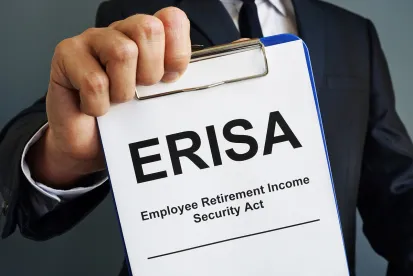On 23 June, the Department of Labor’s (DOL) Employee Benefits Security Administration (EBSA) released a proposed rule, Financial Factors in Selecting Plan Investments (the Proposed Rule). EBSA has regulatory authority over retirement plans created under the Employee Retirement Income Security Act of 1974 (ERISA). The Proposed Rule is designed to address the trend towards environmental, social, and governance (ESG) investing. According to the Proposed Rule, “The [DOL] is concerned . . . that the growing emphasis on ESG investing may be prompting ERISA plan fiduciaries to make investment decisions for purposes distinct from providing benefits to participants and beneficiaries and defraying reasonable expenses of administering the plan.” The release was accompanied by an op-ed from Secretary of Labor Eugene Scalia, in which he describes the Proposed Rule as “remind[ing] plan providers that it is unlawful to sacrifice returns, or accept additional risk, through investments intended to promote a social or political end.”
The Proposed Rule can be traced, in part, to Executive Order 13868 (10 April 2019) (the Executive Order). Section 5 of the Executive Order, titled “Environment, Social, and Governance Issues; Proxy Firms; and Financing Energy Projects Through the United States Capital Markets,” directed the Secretary of Labor to review guidance from the DOL with respect to the “fiduciary responsibilities for proxy voting to determine whether any such guidance should be rescinded, replaced, or modified to ensure consistency with current law and policies that promote long-term growth and maximize return on ERISA plan assets.” At the time, two DOL bulletins provided guidance to ERISA plan fiduciaries on consideration of ESG factors: Interpretive Bulletin 2015-01 (IB 2015-01) and Field Assistance Bulletin 2018-01 (FAB 2018-01).
The Proposed Rule includes a synopsis of interpretive bulletins from 1994 to 2015 and describes them as using an “all things being equal” test when making investment decisions that consider ESG factors.[1] IB 2015-01 allowed investments to be made in “economically targeted investments,” which are “selected for the economic benefits they create apart from their investment return to the employee benefit plan,” so long as the considered factors do not require fiduciaries to sacrifice returns or bear increased risks. FAB 2018-01 sought to clarify IB 2015-01 by noting that the ESG considerations permissible under IB 2015-01 are those “ordinarily collateral issues [that] are themselves appropriate economic considerations.” In other words, the DOL tried to clarify when ESG considerations may also be economic considerations. Secretary Scalia, in his op-ed, makes a similar statement. “Sometimes, ESG factors will bear on an investment’s value.”
In terms of specific changes, IB 2015-01 would be removed but some key elements of IB 2015-01 would be codified as part of the Proposed Rule, such as the recognition of possible overlap between ESG considerations and economic considerations. In codifying parts of IB 2015-01, the Proposed Rule would make certain amendments to the regulations for “investment duties” of ERISA plan fiduciaries. First, language would be added to codify that fiduciaries are required “to select investments and investment courses of action based on financial considerations relevant to the risk-adjusted economic value of a particular investment or investment course of action.” Second, fiduciaries would be unable to subordinate returns in favor of “nonpecuniary” goals. Third, fiduciaries would be required to consider alternative investments to meet plan goals and “nonpecuniary” factors can break a tie between two or more economically indistinguishable investment choices. Fourth, fiduciaries would have to document their analyses when such tiebreakers occur, such as when a toxic chemical leak, to use the example above, is the tiebreaker.
Upon publication in the Federal Register, the Proposed Rule will be open for public comment for 30 days. The Proposed Rule was published in the Federal Register on 30 June, which means comments are due no later than 30 July.
On 23 June, the Department of Labor’s (DOL) Employee Benefits Security Administration (EBSA) released a proposed rule, Financial Factors in Selecting Plan Investments (the Proposed Rule). EBSA has regulatory authority over retirement plans created under the Employee Retirement Income Security Act of 1974 (ERISA). The Proposed Rule is designed to address the trend towards environmental, social, and governance (ESG) investing. According to the Proposed Rule, “The [DOL] is concerned . . . that the growing emphasis on ESG investing may be prompting ERISA plan fiduciaries to make investment decisions for purposes distinct from providing benefits to participants and beneficiaries and defraying reasonable expenses of administering the plan.” The release was accompanied by an op-ed from Secretary of Labor Eugene Scalia, in which he describes the Proposed Rule as “remind[ing] plan providers that it is unlawful to sacrifice returns, or accept additional risk, through investments intended to promote a social or political end.”
The Proposed Rule can be traced, in part, to Executive Order 13868 (10 April 2019) (the Executive Order). Section 5 of the Executive Order, titled “Environment, Social, and Governance Issues; Proxy Firms; and Financing Energy Projects Through the United States Capital Markets,” directed the Secretary of Labor to review guidance from the DOL with respect to the “fiduciary responsibilities for proxy voting to determine whether any such guidance should be rescinded, replaced, or modified to ensure consistency with current law and policies that promote long-term growth and maximize return on ERISA plan assets.” At the time, two DOL bulletins provided guidance to ERISA plan fiduciaries on consideration of ESG factors: Interpretive Bulletin 2015-01 (IB 2015-01) and Field Assistance Bulletin 2018-01 (FAB 2018-01).
The Proposed Rule includes a synopsis of interpretive bulletins from 1994 to 2015 and describes them as using an “all things being equal” test when making investment decisions that consider ESG factors.[1] IB 2015-01 allowed investments to be made in “economically targeted investments,” which are “selected for the economic benefits they create apart from their investment return to the employee benefit plan,” so long as the considered factors do not require fiduciaries to sacrifice returns or bear increased risks. FAB 2018-01 sought to clarify IB 2015-01 by noting that the ESG considerations permissible under IB 2015-01 are those “ordinarily collateral issues [that] are themselves appropriate economic considerations.” In other words, the DOL tried to clarify when ESG considerations may also be economic considerations. Secretary Scalia, in his op-ed, makes a similar statement. “Sometimes, ESG factors will bear on an investment’s value.”
In terms of specific changes, IB 2015-01 would be removed but some key elements of IB 2015-01 would be codified as part of the Proposed Rule, such as the recognition of possible overlap between ESG considerations and economic considerations. In codifying parts of IB 2015-01, the Proposed Rule would make certain amendments to the regulations for “investment duties” of ERISA plan fiduciaries. First, language would be added to codify that fiduciaries are required “to select investments and investment courses of action based on financial considerations relevant to the risk-adjusted economic value of a particular investment or investment course of action.” Second, fiduciaries would be unable to subordinate returns in favor of “nonpecuniary” goals. Third, fiduciaries would be required to consider alternative investments to meet plan goals and “nonpecuniary” factors can break a tie between two or more economically indistinguishable investment choices. Fourth, fiduciaries would have to document their analyses when such tiebreakers occur, such as when a toxic chemical leak, to use the example above, is the tiebreaker.
Upon publication in the Federal Register, the Proposed Rule will be open for public comment for 30 days. The Proposed Rule was published in the Federal Register on 30 June, which means comments are due no later than 30 July.
Notes
[1] The Proposed Rule discusses DOL’s first interpretive bulletins released on this subject, including Interpretive Bulletin 94-1 and its successor, Interpretive Bulletin 2008-01 (IB 2008-01). IB 2008-01 was later superseded by IB 2015-01.







 />i
/>i
